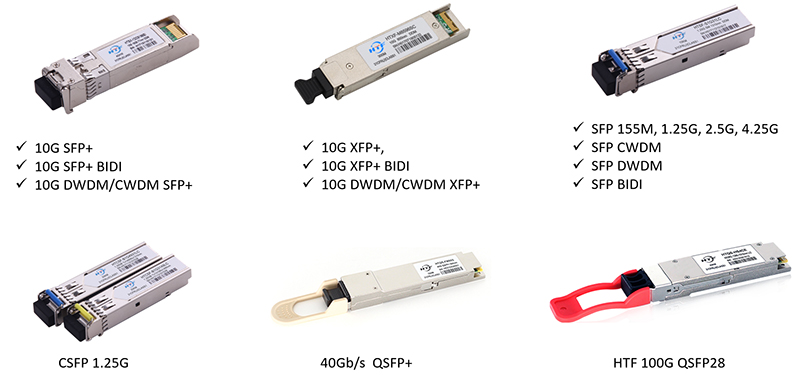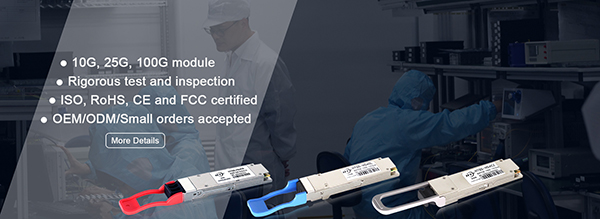1. Interface Rate
Before selecting the rate of an optical module, you need to confirm the rate supported by the switch port, and then select the rate of the optical module based on the rate supported by the switch. The rates of optical modules can be FE(155M), GE(1.25G), 10GE, 25GE, 40GE, 100GE, or 400GE. In addition, there are commonly used for storage network (SAN) fiber channel 8G, 16G rate (widely used by Brocade devices).
2. Transmission Distance
Optical modules with different rates, wavelengths, and packages support different transmission distances. Therefore, it is important to determine the transmission distances.For example,SFP-10G-SR 10G multimode optical module can only reach 300m, and SFP-10G-ZR 10G single mode optical module can reach 80km.
The luminescence of optical modules varies with the distance specifications. Note that (usually during field tests), the transmitted optical power of a long-distance optical module is greater than the overload optical power. Therefore, you need to pay attention to the length of the optical fiber to ensure that the actual received optical power is less than the overload optical power. If the length of the optical fiber is short, use the optical attenuation (dB/km) of the optical fiber to avoid burning out the peer optical module.
3. Optical Fiber Type
Optical fibers can be classified into single mode and multimode optical fibers. The central wavelength of a single mode optical module is 1310nm and 1550nm, which are used together with single mode optical fibers. Single mode fiber has transmission frequency bandwidth and large transmission capacity, suitable for long distance transmission. The central wavelength of a multimode optical module is 850nm, which is used together with multimode optical fibers. Multimode fiber has the defect of mode dispersion, and its transmission performance is worse than that of single mode fiber, but its cost is low, and it is suitable for small capacity and short distance transmission.
4. Optical Fiber Interface
Common module interfaces include LC,SC, MPO, etc., but the cost of the project and future upgrade and expansion should be considered comprehensively. For example, 40G QSFP+ multimode interface is generally an MPO interface, using MPO patch cord, the cost of optical module is low, but the cost of MPO patch cord laying is high. 40G QSFP+ also has LC interface specifications, using LC patch cord, cable laying cost is lower. So this is the need to combine the actual situation to make a comprehensive decision. In addition, the optical fiber interface of different optical modules is different, so we need to know the corresponding optical fiber interface of the optical module before purchasing the suitable optical fiber patch cord. For example, the interface type of 1.25G BiDi simplex optical module includes LC and SC, which needs to be confirmed with the manufacturer.
5. Operating Temperature
The operating temperature of the optical module ranges from 0℃-70℃ for commercial, -20℃-85℃ for expansion, and -40℃-85℃ for industrial. Optical modules with the same package, rate, and transmission distance are available in commercial and industrial versions. Industrial-grade products are more expensive because they use devices that are more resistant to temperature. You need to set the operating temperature of the optical module based on the actual operating environment.
6. Compatibility
Because major equipment vendors tend to close the ecosystem in order to provide consistent products and services. As a result, optical modules cannot be mixed with devices of different brands. When purchasing an optical module, you need to explain the devices on which the optical module is to be used to avoid incompatible devices.
7. Price
Generally,the price of optical modules that the brand of optical modules and the equipment brand of the same is expensive,The performance and quality of third-party optical modules are the same as those of brand optical modules, but the price has obvious advantages.
8. Quality and After-sales Service
Optical modules usually have no problems in the first year of use and most of them appear in the later period. So try to choose suppliers with stable quality.
HTF carries out product parameter performance test, appearance test, compatibility and interoperability test and optical end face cleaning before all products leave the factory to ensure that users can get high-quality optical modules.
If you have any doubts on SFP/XFP/QSFP28/CSFP/DWDM optical transceive, HTF provide technical support for free, if need support, welcome to contact HTF team, info@htfuture.com 008618123672396



